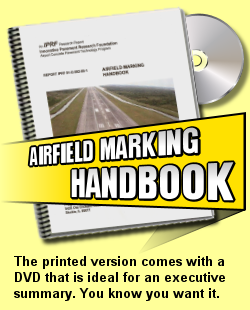|
Back to Webletter
AMH - Airfield Marking Handbook
By Mike Speidel
 The Airfield Marking Handbook is currently being printed - we expect it to be released for
public consumption in two weeks, or early October. We promise it will be worth the wait - after all, perfection
takes time! If you buy printed copies directly from the IPRF, the cost will be about $15 US. The print version
contains a Supplemental DVD which is fantastic (actually I put that together so I am biased, big time)! The AMH
will also be available in PDF format on the IPRF site. Sightline.us will provide a download link on our homepage
as well.
The Airfield Marking Handbook is currently being printed - we expect it to be released for
public consumption in two weeks, or early October. We promise it will be worth the wait - after all, perfection
takes time! If you buy printed copies directly from the IPRF, the cost will be about $15 US. The print version
contains a Supplemental DVD which is fantastic (actually I put that together so I am biased, big time)! The AMH
will also be available in PDF format on the IPRF site. Sightline.us will provide a download link on our homepage
as well.
The AMH is organized into seven chapters, as described below. Each chapter addresses a
major aspect toward attaining airfield marking quality, and can be read independently of the others. As the
principal authors of the AMH, we will be discussing each chapter via the next several issues of this webletter.
We will describe, in detail, what needs to be derived from each chapter to make this Handbook come to life -
instead of becoming just another manual on the shelf. What's inside:
- Chapter 1-Introduction: This chapter introduces the handbook and its organization.
- Chapter 2-Specifications for Construction and Maintenance Activities: This chapter addresses the
specifications of markings, the construction/installation of markings, and the maintenance of markings. Key
elements in the chapter include selecting proper specifications, evaluating existing conditions appropriately, and
defining the scope of work based on the existing conditions.
- Chapter 3-Materials: This chapter identifies various materials that are used in airfield markings, including
both binder and beads. It provides guidelines for the proper selection of materials under specific circumstances.
Selecting the correct materials for a given airfield is important in establishing good marking performance.
- Chapter 4-Surface Preparation: This chapter describes the processes that can be used to prepare a surface
for the application of airfield markings. Surface preparation includes either cleaning or removing anything that
would reduce the bond between a newly applied material and the surface. Surface preparation is necessary any time
markings are applied.
- Chapter 5-Pavement Marking Removal: This chapter identifies various practices that can be used to remove
airfield markings from the pavement surface. Many factors determine which removal method is the best for a
specific set of conditions. The proper removal method helps to minimize pavement scarring; removing the appropriate
amount of marking can optimize the life of the new marking application and minimize confusion.
- Chapter 6-Application Procedures: This chapter describes the processes used to apply markings to an airfield
pavement surface. Many factors that can have an impact on the quality of the installation and the performance of
the marking are reviewed.
- Chapter 7-Inspection: This chapter describes ways to inspect various aspects of airfield marking application.
Throughout the handbook, best practices are identified by bold text (a best practice) within a chapter.
The airports that adopt these practices will not only improve their marking program by providing longer-lasting, more-effective
airfield markings, they will also save valuable maintenance funds. You can do it, we can help.
Back to Webletter
|



 The Airfield Marking Handbook is currently being printed - we expect it to be released for
public consumption in two weeks, or early October. We promise it will be worth the wait - after all, perfection
takes time! If you buy printed copies directly from the IPRF, the cost will be about $15 US. The print version
contains a Supplemental DVD which is fantastic (actually I put that together so I am biased, big time)! The AMH
will also be available in PDF format on the IPRF site. Sightline.us will provide a download link on our homepage
as well.
The Airfield Marking Handbook is currently being printed - we expect it to be released for
public consumption in two weeks, or early October. We promise it will be worth the wait - after all, perfection
takes time! If you buy printed copies directly from the IPRF, the cost will be about $15 US. The print version
contains a Supplemental DVD which is fantastic (actually I put that together so I am biased, big time)! The AMH
will also be available in PDF format on the IPRF site. Sightline.us will provide a download link on our homepage
as well.